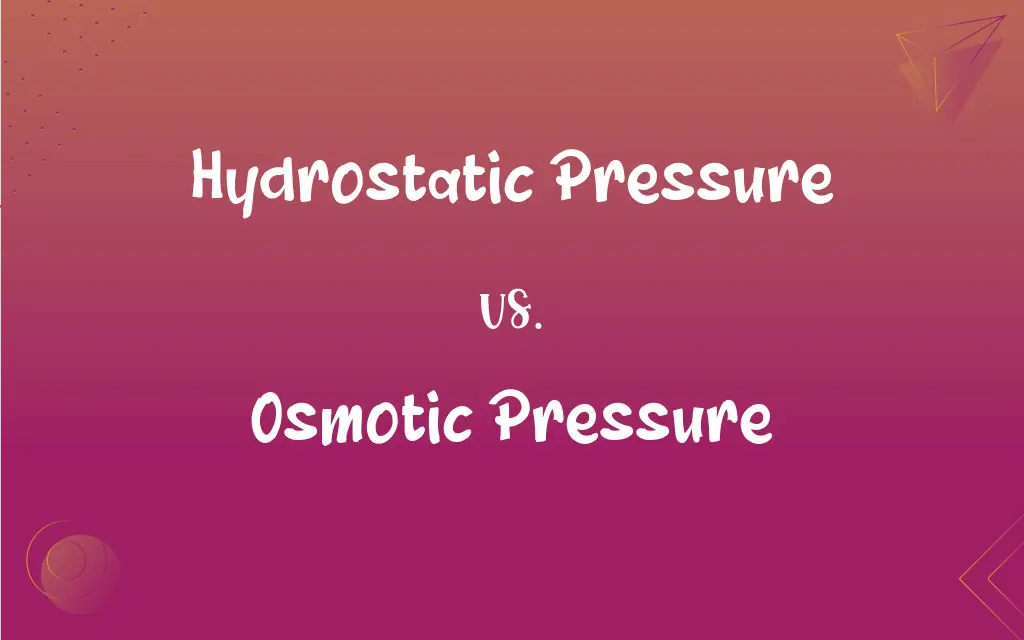Hydrostatic Pressure vs. Osmotic Pressure: What's the Difference?
Edited by Aimie Carlson || By Janet White || Published on March 7, 2024
Hydrostatic pressure is the force exerted by a fluid at rest due to gravity, while osmotic pressure is the force needed to prevent solvent movement across a semipermeable membrane.

Key Differences
Hydrostatic pressure is the pressure exerted by a fluid at equilibrium due to the force of gravity, acting perpendicular to any surface in contact with the fluid. Osmotic pressure, on the other hand, is the minimum pressure required to prevent the inward flow of a solvent into a solution through a semipermeable membrane, driven by concentration differences.
Hydrostatic pressure results from the weight of the fluid itself and is influenced by the fluid's density and the height of the fluid column. In contrast, osmotic pressure is generated due to the presence of solute particles in a solution, creating a concentration gradient that drives the movement of the solvent molecules through the semipermeable membrane.
In biological systems, hydrostatic pressure plays a crucial role in maintaining blood pressure and fluid balance within blood vessels. Osmotic pressure, however, is key to maintaining proper cell function, regulating the movement of water in and out of cells, ensuring that cells neither swell excessively nor dehydrate.
Hydrostatic pressure is commonly measured in units of pascals (Pa) or millimeters of mercury (mmHg), depending on the context. Osmotic pressure is also measured in units of pressure such as pascals but is specifically derived from the concentration of solutes and temperature, following the van't Hoff equation in ideal solutions.
Hydrostatic pressure is crucial in hydrology, civil engineering, and fluid mechanics, affecting the design of dams, water supply systems, and the behavior of natural water bodies. Osmotic pressure has significant implications in medical treatments like dialysis, food preservation techniques, and understanding of plant nutrient uptake and cell turgidity.
ADVERTISEMENT
Comparison Chart
Source
Weight of fluid and gravity
Solute concentration and semipermeable membrane
Measured In
Pascals (Pa), mmHg
Pascals (Pa)
Role in Biology
Maintains blood pressure, fluid balance in vessels
Regulates cell water content, maintains cell turgor
Applications
Hydrology, civil engineering, fluid mechanics
Dialysis, food preservation, plant physiology
Influencing Factors
Fluid density, height of fluid column
Solute concentration, temperature, solvent properties
ADVERTISEMENT
Hydrostatic Pressure and Osmotic Pressure Definitions
Hydrostatic Pressure
Hydrostatic pressure is the pressure exerted by a fluid in equilibrium due to gravity.
The hydrostatic pressure at the bottom of a lake increases with depth.
Osmotic Pressure
Osmotic pressure is the force that drives solvent molecules across a semipermeable membrane.
Plant roots utilize osmotic pressure to absorb water from the soil.
Hydrostatic Pressure
Hydrostatic pressure is directional, always acting perpendicular to any surface.
The hydrostatic pressure against a dam's wall is crucial for structural integrity assessments.
Osmotic Pressure
Osmotic pressure is a colligative property, depending only on solute particle number.
Osmotic pressure calculations are crucial in determining molecular weights in biochemistry.
Hydrostatic Pressure
Hydrostatic pressure reflects the weight of the fluid column above the measurement point.
Hydrostatic pressure helps explain why water pressure in homes is lower at higher floors.
Osmotic Pressure
Osmotic pressure is influenced by solute concentration and temperature.
Increasing solute concentration in a solution raises its osmotic pressure.
Hydrostatic Pressure
It's the force per unit area exerted by a liquid at rest.
Engineers consider the hydrostatic pressure when designing dams.
Osmotic Pressure
This pressure helps maintain the balance of fluids in cells and tissues.
Osmotic pressure keeps red blood cells from bursting in hypotonic solutions.
Hydrostatic Pressure
This pressure is vital for understanding fluid behavior in various contexts.
Hydrostatic pressure readings can indicate whether a fluid container might rupture.
Osmotic Pressure
It's a measure of the tendency of a solvent to move into a solution via osmosis.
Osmotic pressure differences are essential in kidney dialysis processes.
FAQs
What is hydrostatic pressure?
It's the pressure exerted by a fluid at rest, mainly due to gravity.
What is osmotic pressure?
Osmotic pressure is the minimum pressure needed to prevent solvent flow across a semipermeable membrane, driven by solute concentration differences.
How is hydrostatic pressure measured?
It's typically measured in pascals or mmHg, depending on the fluid's depth and density.
What role does hydrostatic pressure play in the human body?
It helps maintain blood pressure and fluid distribution between blood vessels and tissues.
What role does osmotic pressure play in the human body?
It regulates fluid balance within and between cells, preventing cell swelling or shrinkage.
In what industries is understanding hydrostatic pressure important?
It's crucial in hydrology, civil engineering, and any field involving fluid storage or movement.
Can hydrostatic pressure affect osmotic pressure in a system?
Yes, in biological and artificial systems, both pressures can interact, influencing net fluid movement across membranes.
Does the type of solvent affect osmotic pressure?
Yes, solvent properties can influence how solutes dissolve and interact, affecting osmotic pressure.
Can hydrostatic pressure be zero?
Yes, at the surface of a fluid where there is no depth, hydrostatic pressure is zero.
How do hydrostatic and osmotic pressure differ in driving fluid movement?
Hydrostatic pressure drives fluids based on gravity and fluid weight, while osmotic pressure drives solvent molecules across membranes based on solute concentration gradients.
What happens if osmotic pressure is not maintained in a cell?
It can lead to cell swelling (lysis) or shrinking (crenation), disrupting normal cell function.
Can hydrostatic pressure be controlled or adjusted?
Yes, it can be adjusted by changing the fluid's height, density, or local gravitational conditions.
How is osmotic pressure measured?
It's measured in units of pressure, often calculated based on solute concentration and temperature.
In what applications is understanding osmotic pressure important?
It's vital in medical treatments like dialysis, food technology, and studying plant physiology.
Can osmotic pressure be negative?
Theoretically, no. Osmotic pressure is a measure of the tendency to attract water, which can't be negative.
How do you calculate osmotic pressure?
It's often calculated using the van't Hoff equation, relating solute particle number, temperature, and a constant.
How do you calculate hydrostatic pressure?
It's calculated as the product of fluid density, gravity, and height of the fluid column.
How does temperature affect hydrostatic and osmotic pressure?
While hydrostatic pressure is mostly unaffected by temperature, osmotic pressure increases with temperature due to increased solute solubility and kinetic energy of molecules.
Can osmotic pressure be controlled or adjusted?
Yes, by altering solute concentration, temperature, or using osmotic agents.
What happens if hydrostatic pressure is too high in a system?
It can lead to structural failure of containers or undesired fluid movement in biological systems.
About Author
Written by
Janet WhiteJanet White has been an esteemed writer and blogger for Difference Wiki. Holding a Master's degree in Science and Medical Journalism from the prestigious Boston University, she has consistently demonstrated her expertise and passion for her field. When she's not immersed in her work, Janet relishes her time exercising, delving into a good book, and cherishing moments with friends and family.
Edited by
Aimie CarlsonAimie Carlson, holding a master's degree in English literature, is a fervent English language enthusiast. She lends her writing talents to Difference Wiki, a prominent website that specializes in comparisons, offering readers insightful analyses that both captivate and inform.































































